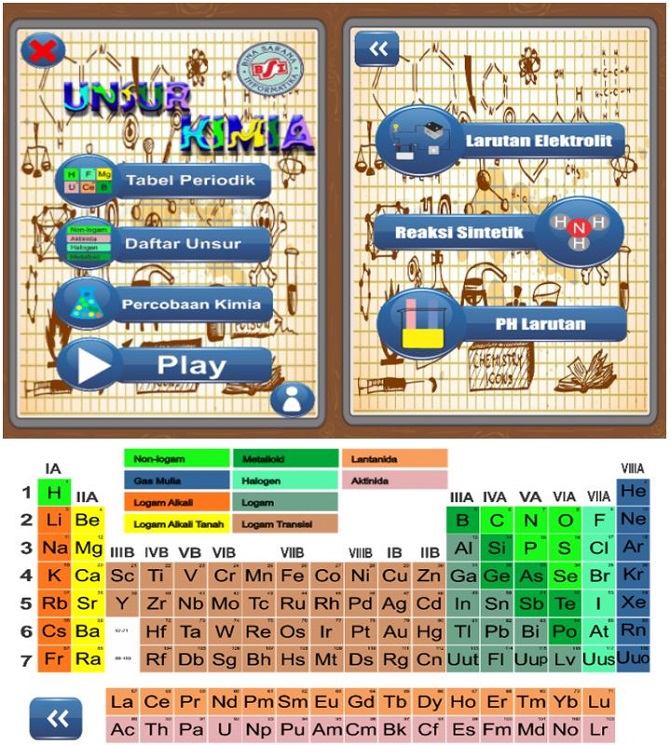
Android-based Animation for Chemical Elements and Experiments as an Interactive Learning Media
Abstract
References
Aksad, H. (2018). Rancang Bangun Game Adventure Burung Enggang Berbasis Android Menggunakan Scirra Construct 2. Progresif: Jurnal Ilmiah Komputer, 13(2), 1771–1782.
Aziz, I. A., Setiawan, B., Khanh, R., Nurdiyansyah, G., & Yulianti, Y. (2020). Pengujian Black Box pada Aplikasi Sistem Kasir Berbasis Website Menggunakan Teknik Equivalence Partitions. Jurnal Teknologi Sistem Informasi Dan Aplikasi, 3(2), 82–89.
Budiharjo, S., & Yulianto, A. D. (2014). Rancang bangun aplikasi quiz telekomunikasi berbasis android. Journal ICT, 5(8), 70–79.
Busran, B., & Yunanda, N. D. (2015). Rancang Bangun Aplikasi Pembelajaran Iqra Untuk Anak Usia Dini Berbasis Android. Jurnal Momentum, 17(1), 78–83.
El-Hussein, M. O. M., & Cronje, J. C. (2010). Defining mobile learning in the higher education landscape. Journal of Educational Technology & Society, 13(3), 12–21.
Eliyawati, E., Agustin, R. R., Sya’bandari, Y., & Putri, R. A. H. (2014). Smartchem: An Android Application for Learning Multiple Representations of Acid-Base Chemistry. Journal of Science Learning, 3(3), 196–204.
Fudholi, A. (2015). Animasi Interaktif Pembelajaran Pengenalan Dan Perancangan Jaringan Komputer. Penelitian Ilmu Komputer Sistem Embedded Dan Logic, 3(1), 28–40.
Fujiawati, F. S., & Raharja, R. M. (2019). Analisis Kesiapan Mahasiswa Pendidikan Seni Mengaplikasikan Pembelajaran Berbasis Online (E-Learning & Mobile Learning). JPKS (Jurnal Pendidikan Dan Kajian Seni), 4(2), 150–164.
Hafidha, P. N. W. (2014). Augmented Reality Sistem Periodik Unsur Kimia Sebagai Media Pembelajaran Bagi Siswa Tingkat SMA Berbasis Android Mobile. Komuniti: Jurnal Komunikasi Dan Teknologi Informasi, 6(2), 122–131.
Kurniawati, L. S., & Priyanto. (2018). The Effect of Mobile Learning on Senior High School (SMA): Case Study at Public Senior High School (SMA Negeri) in Yogyakarta. Journal of Physics: Conference Series, 1140, 12017. https://doi.org/10.1088/1742-6596/1140/1/012017
Lubis, I. R., & Ikhsan, J. (2015). Pengembangan media pembelajaran kimia berbasis android untuk meningkatkan motivasi belajar dan prestasi kognitif peserta didik SMA. Jurnal Inovasi Pendidikan IPA, 1(2), 191–201.
Meidayanti, R., Sunyono, S., & Tania, L. (2015). Pembelajaran SiMaYang Tipe II untuk Meningkatkan Self-Efficacy dan Keterampilan Berpikir Kritis. Jurnal Pendidikan Dan Pembelajaran Kimia, 4(3), 856–867.
Mustaqbal, M. S., Firdaus, R. F., & Rahmadi, H. (2015). Pengujian aplikasi menggunakan black box testing boundary value analysis (studi kasus: Aplikasi prediksi kelulusan smnptn). Jurnal Ilmiah Teknologi Infomasi Terapan, 1(3), 31–36.
Nasution, M. I. P. (2016). Strategi pembelajaran efektif berbasis mobile learning pada sekolah dasar. IQRA’: Jurnal Perpustakaan Dan Informasi, 10(1), 1–14.
Nuqisari, R., & Sudarmilah, E. (2019). Pembuatan Game Edukasi Tata Surya dengan Construct 2 Berbasis Android. Emitor: Jurnal Teknik Elektro, 19(2), 86–92.
Pratama, A., Yuanita, L., & Susantini, E. (2016). Pengembangan Perangkat Pembelajaran Kimia Berbasis Strategi Belajar Peta Konsep untuk Meningkatkan Pemahaman Konsep dan Kemampuan Berpikir Kritis Siswa SMA. JPPS (Jurnal Penelitian Pendidikan Sains), 5(2), 1023–1031.
Rahayu, S. (2017). Mengoptimalkan Aspek Literasi dalam Pembelajaran Kimia Abad 21. Prosiding Seminar Nasional Kimia UNY, 21, 1–16.
Rastegarpour, H., & Marashi, P. (2012). The effect of card games and computer games on learning of chemistry concepts. Procedia-Social and Behavioral Sciences, 31, 597–601. https://doi.org/10.1016/j.sbspro.2011.12.111
Sukamto, R. A., & Shalahuddin, M. (2013). Rekayasa perangkat lunak terstruktur dan berorientasi objek. Bandung: Informatika, 3.
Rusdi, H., & Yunus, M. (2016). Pengembangan Media Pembelajaran Berbasis Android “ChemBird” Pada Materi Kimia Kelas XI di SMAN 17 Makassar. Jurnal Ecosystem,16(2),290–301.
Saputra, D., & Rafiqin, A. (2017). Pembuatan Aplikasi Game Kuis “Pontianak Punye” Berbasis Android. Jurnal Khatulistiwa Informatika, 5(2), 71–85.
Shabrina, S., Warsono, W., & Kuswanto, H. (2017). Android Used in The Learning Innovation Atwood Machines on Lagrange Mechanics Methods. International Journal of Science and Applied Science: Conference Series, 2(1), 338–345.
Sunarya, E. N., Prima, E. C., & Wihardi, Y. (2020). The Development of ‘E-Layer’Android Mobile Application as Interactive Multimedia in Earth Layer Topics for Junior High School. PervasiveHealth: Pervasive Computing Technologies for Healthcare, 1, 1437-1444.
Syafaruddin, S., Mesiono, M., Butar-Butar, A., & Assingkily, M. S. (2020). Manajemen Pembelajaran Pendidikan Agama Islam di SDIT Bunayya Pandan Kabupaten Tapanuli Tengah. AULADUNA: Jurnal Pendidikan Dasar Islam, 7(1), 32–45.
Traxler, J. (2005). Defining mobile learning. IADIS International Conference Mobile Learning, 261–266.
Widaningrum, I., Prasetiyo, H., & Astuti, I. P. (2020). Android Based Math & Trash Educational Game Using Scirra Construct 2 and Adobe Phonegap. Jurnal RESTI (Rekayasa Sistem Dan Teknologi Informasi), 4(1), 37–49.
Yasin, A. I., Prima, E. C., & Sholihin, H. (2018). Learning Electricity Using Arduino-Android Based Game to Improve STEM Literacy. Journal of Science Learning, 1(3), 77–94.
DOI: https://doi.org/10.17509/jsl.v4i2.28787
Refbacks
- There are currently no refbacks.
Copyright (c) 2021 Dedi Saputra, Burcu Gürbüz, Haryani Haryani

This work is licensed under a Creative Commons Attribution-ShareAlike 4.0 International License.


Jl. Dr. Setiabudhi 229 Bandung 40154, West Java, Indonesia











